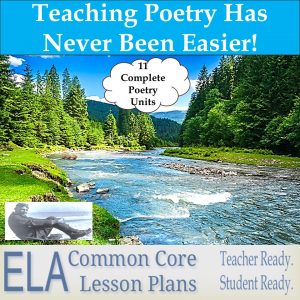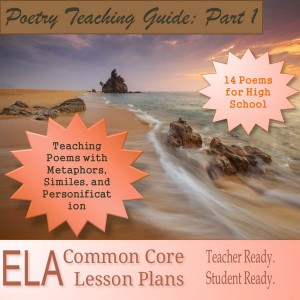Poems for Teaching Metaphors
After your students have had an introduction to metaphors, cement their knowledge by practicing with these poems.
Here’s a poetry metaphor handout you can use with any poem with metaphors.
Let’s Start with Caged Birds Metaphors in Poetry

Imagine having 11 complete poetry units with handouts and lesson plans completed. You don’t need to imagine. These units are teacher ready and student ready. Just print, make copies, and accept accolades from colleagues and students.
Some metaphors are carried through multiple poems.
- “I know why the caged bird sings” by Maya Angelou – This metaphor poem is perhaps the most famous. Angelou uses a caged bird and its song of freedom as a metaphor for her people. The metaphor of a caged bird can be applied to any opressed group or individuals. Paul Laurence Dunbar uses the metaphor in “Sympathy,” and Susan Glaspell uses it in “Trifles.”
- “Sympathy” by Paul Laurence Dunbar – Dunbar takes up the caged bird metaphor and uses a first person perspective to explain how the caged bird feels and why the caged bird sings.
- “Well, I Have Lost You; and I Lost You Fairly” by Edna St. Vincent Millay – Since we’re discussing caged bird metaphors — Millay uses the bird in a cage metaphor to explain why she lost her lover.
Lesson Idea
Since we’re on the subject of caged-bird metaphors, check out this lesson plan.
- Read any or all of the above poems.
- Brainstorm a list of things that represent freedom.
- Have each student create an individual list of what represents freedom.
- List what is preventing each student from achieving his or her personal definition of freedom.
- Instruct students to draw the caged-bird metaphor. The drawing could be strictly a bird in a cage, what the bird in the cage represents, or a combination of the two.
- This assignment can be done with a goal setting activity.
Poems for Teaching Metaphors

There’ll be no more stammering through 45 minutes of discussing a poem that takes 2 minutes to read. The Poetry Part 1 teaching guide includes a summary and analysis of 14 poems; a ready-to-annotate and analyze copy of each poem; graphic organizers for digging deeper into metaphors, similes, personification, imagery, and theme; a guide for annotating and analyzing a poem; and answer keys for everything.
It’s all bundled into one nice pdf. All you need to do is make copies and do what you do.
Here’s a couple more poems for teaching metaphors.
1. “Alley Rats” by Carl Sandburg – Sandburg satirizes the use of metaphoric nicknames used for gangsters and their facial hair. Read carefully, for the ending is metaphorically ironic. The title of the poem refers to the lowlife scum that inhabit certain cities, yet receive favorable press through the use of “cute” nicknames.
- Lesson Idea: Research different ways newspapers and other media outlets use language to make the base seem exalted and evil seem good or innocuous.
2. “The Glory of the Day Was in Her Face” by James Weldon Johnson – Johnson uses metaphors associated with living and nature to describe how the woman he loves makes him complete. Since his lover is gone, he no longer enjoys the very things she reminded him of.
- Lesson Idea: Nothing like a good, sappy, love poem to motivate teenagers. Instruct them to list 5-10 metaphors regarding someone they care for.
3. “Dreams” or “What Happens to a Dream Deferred” by Langston Hughes.
ELA Common Core Standards Covered
Teaching imagery in poems may cover the following ELA Common Core Standards. This is for your administrator, not your kids. Kids need student-friendly worded objectives.
- RL.9-10.1 Cite strong and thorough textual evidence to support analysis of what the text says explicitly as well as inferences drawn from the text.
- RL.9-10.2 Determine a theme or central idea of a text and analyze in detail its development over the course of the text, including how it emerges and is shaped and refined by specific details; provide an objective summary of the text.
- RL.9-10.4 Determine the meaning of words and phrases as they are used in the text, including figurative and connotative meanings; analyze the cumulative impact of specific word choices on meaning and tone (e.g., how the language evokes a sense of time and place; how it sets a formal or informal tone).
- RL.9-10.10 By the end of grade 9, read and comprehend literature, including stories, dramas, and poems, in the grades 9-10 text complexity band proficiently, with scaffolding as needed at the high end of the range. By the end of grade 10, read and comprehend literature, including stories, dramas, and poems, at the high end of the grades 9-10 text complexity band independently and proficiently.
Teaching Literary Elements with Poems
Understanding literary elements is necessary for literary analysis. These poems will help you teach literary elements.
- Poems for Teaching Imagery
- Poems for Teaching Metaphors
- Poems for Teaching Personification
- Poems for Teaching Onomatopoeia
- Poems for Teaching Sound Devices
- Poems for Teaching Meter
- Poems for Teaching Alliteration
Last Updated on February 27, 2018 by Trenton Lorcher
Share This: